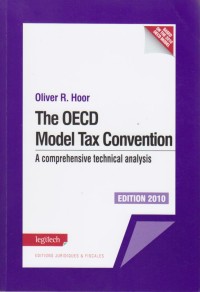
Book
The OECD Model Tax Convention - A Comprehensive Technical Analysis
The volume of cross-border transactions realized by individuals and enterprises has soared dramatically in recent years amid an increasingly globalized economy. In these circumstances, taxpayers are frequently subject to tax in two (or more) jurisdictions which is an obstacle to international trade and investment. Unilateral measures may help for the avoidance of double taxation (for example, a state withdraws its tax claim), but most certainly will not suffice for an effective avoidance of double taxation since they fall short of comprehensive and lack consistency. Each State therefore weaves its own web of tax treaties to protect taxpayers against double taxation and thus preventing the discouragement which double taxation may provide in the free flow of international trade and investment. Tax treaties play a vital role in a global economy, attempting to reconcile the complex and ever-changing internal tax laws of different countries. Most tax treaties worldwide are based on the OECD's Model Convention with respect to taxes on income and on capital (OECD Model Convention) and follow both its structure and wording. The main purpose of the OECD Model is the settling of the most common problems that arise in the field of international double taxation. Its starting point is the dilemma which arises where the same income or capital is subject to tax in the taxpayer's residence state and the state from which the income derives. Notably the basis for the allocation of taxing rights varies for different categories of income and capital. The fundamental principle that pervades the OECD Model Convention is however that the allocation of taxing rights stems from the substantive economic nexus of income and capital. Thereby tax treaties restrict certain income tax provisions under domestic tax law in order to avoid - or at least mitigate - double taxation. The mechanisms for the avoidance of double taxation provided by the OECD Model Convention are complex and the methods for the distribution and allocation of taxing rights between Contracting States particularly tortuous. A clear and complete understanding of the mechanics of the OECD Model is essential to each tax analysis involving cross-border transactions all the more amid the increasing strategic importance of tax treaties in international trade and investment. Reading this thorough and authoritative guide is indispensable for an in-depth understanding of the OECD Model; charts overviews and case studies* will accompany the reader in assessing the vital elements to consider in each tax analysis. Tax advisers finance managers business practitioners and tax students should gain substantially from the insights provided in this book. This book is written on the basis of the OCED Model as it read on 22 July 2010.""
Detail Information
| Call Number |
17 OEC oli
|
|---|---|
| Publisher | Legitech : Luxembourg., 2010 |
| Collation |
412p.; 24cm
|
| Language |
English
|
| Classification |
17 OEC oli
|
| ISBN/ISSN |
978-99959-626-9-2
|
| Edition |
Edition 2010
|
| Subject(s) |
-
|






